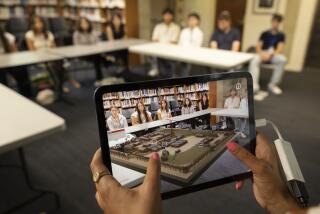Traveling Museum Allows Students to Touch the Past : Education: Ray Glazner tours schools with his own museum. He says students “remember what they can touch.”
- Share via
Ray Glazner goes Back to the Past. And he does it with special effects, though not the stuff of Steven Spielberg. His props--beaver skins, moccasins, bayonets--are real-life replicas of another era in American history, when revolution had only begun to reach the colonial consciousness.
He is his own museum--he calls it “Images of the Past,” and he takes his exhibits to San Fernando Valley-area schools and clubs. Bearded and burly, he looks the part of an early settler, primed to capture his prey in the wilderness and cook it on a campfire.
But Glazner is actually a retired schoolteacher from New Jersey.
“Over the years,” said Glazner, 48, of Simi Valley, “I’ve collected enough stuff to do any period in American, or even world, history.”
By reading “lifeless” textbooks, Glazner believes, most students don’t feel connected to the major themes and symbols of American history; they simply memorize dates and names. By displaying dozens of artifacts from pre- and post-Revolutionary War days, Glazner hopes to make a more lasting impression.
“Ask them what they read in a history book and they wouldn’t be able to tell you,” Glazner said, “but ask them the details of a movie they saw and they can tell you everything. They remember what they can touch.”
They touch everything. During a recent presentation at Fairfield School in Van Nuys, third-graders were fascinated with Glazner’s artifacts, asking dozens of questions. On this day, he dressed up as a pre-Revolutionary War merchant, wearing breeches, a waistcoat and black boots. When he finished explaining the historical significance of the items, about 50 in all, the students filed up to the rectangular table and played with the past.
“You don’t find things like this around now,” said Danielle Judis, 8. “I like learning about what happened in the old days.”
Glazner experienced the same curiosity when he attended elementary school in New Jersey in the early 1950s. He had a teacher who has served as his role model.
“He had just returned from Korea,” Glazner said, “and he would bring in things from the war. He made it so easy to hear and see things. I decided right then that this would be how I was going to teach.”
Glazner benefited from growing up in a well-to-do family with a passion for collecting antiques. Each weekend, his family spent hours at antique shops. His parents would check on glass and furniture, but Glazner headed straight for the military items.
“A gun was more exciting than a piece of glass,” he recalled. “We used to hunt all the time, and so guns meant a lot to us.”
Since then, Glazner has gradually collected pieces of American history wherever he could obtain them--swap meets, antique shops, museums, organized historical festivals. Some he keeps for himself, and others he uses in his presentations. He’s not afraid to make expensive purchases, such as the $1,500 he spent on a 1783 Pennsylvania rifle, considering them valuable long-term investments. He receives $200 a day from schools, although he says at his current pace--about one class a week--he will only net about $10,000 this academic year.
After 25 years as an elementary and junior high school teacher in Bloomsburg, N.J., Glazner headed west to California after his wife, Linda, became chairman of the occupational health department at UCLA. He began “Images of the Past” in June, 1988. He considered returning to full-time teaching, but resented the state of California’s requirement that teachers must pass math aptitude tests.
“I’ll be damned if I have to take a class in geometry and trigonometry,” Glazner said, “when it’s stuff I’m not going to use.”
Instead, he’s aiming for a schedule that would take him to about 100 to 150 schools per year. He says once he’s visited a school, “they always ask me back,” but the hard part is getting there in the first place. On days he’s not giving his presentation, Glazner is contacting schools, mailing brochures or searching for more artifacts. History, he asserts, isn’t given its proper respect in the schools.
“Kids don’t even know how to visit a museum,” Glazner said. “They get bored really quickly. The objects are behind glass, and so they can’t touch them. All they see are these cards that explain what the objects are, which is just more reading for them. They get enough of that at school.”
Even when there might be interest, Glazner understands the inherent limitations of school districts. “Not every teacher interested in artifacts can afford them, and the schools can’t pay for them, either.”
Glazner has a simple answer.
“Me.”
More to Read
The biggest entertainment stories
Get our big stories about Hollywood, film, television, music, arts, culture and more right in your inbox as soon as they publish.
You may occasionally receive promotional content from the Los Angeles Times.










